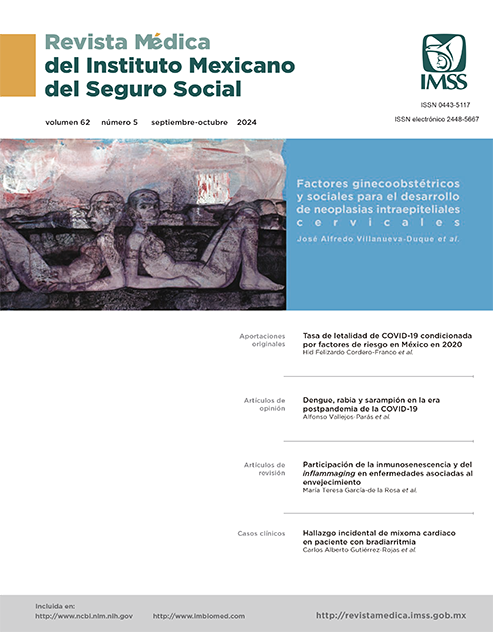Events attributable to Vaxzevria vaccine in pregnant women from a first-level hospital in Puebla
Main Article Content
Keywords
Abstract
Background: COVID-19 is a severe acute respiratory syndrome caused by SARS-CoV-2. This disease had a high mortality rate and turned into a pandemic, which is why it was considered a severe public health problem. In this context, pregnant patients were a vulnerable group and, consequently, an effective vaccine was necessary.
Objective: To categorize the events attributable to the application of Vaxzevria vaccine in pregnant patients.
Material and methods: Retrospective, cross-sectional, descriptive and observational study carried out at No. 55 Family Medicine Unit in Puebla, Puebla. 300 patients between 15 and 44 years of age who received the first dose of Vaxzevria vaccine were included. The Format of Notification of Events Presumably Attributable to Vaccination was reviewed.
Results: The most representative general symptoms were headache in 44.3%; fever in 30.7%; asthenia and adynamia in 19.3%; adynamia in 19%, and limitation of movement in 3%. Concerning local symptoms and signs, 23% presented localized pain on the site where the vaccine was administered. Finally, regarding systemic symptoms, 21.7% had arthralgias and 20.7% myalgias.
Conclusions: The symptoms and signs were of less severity for pregnant patients, and resolved in a few days, which is why it was safe the administration of Vaxzevria vaccine.
References
Cui J, Li F, Shi ZL. Origen y evolución de coronavirus patógenos. Nat Rev Microbiol. 2019;17(3):181-92. doi: 10.1038/s41579-018-0118-9.
Malik YA. Properties of Coronavirus and SARS-CoV-2. Malays J Pathol. 2020;42(1):3-11.
Liu YC, Kuo RL, Shih SR. COVID-19: The first documented coronavirus pandemic in history. Biomed J. 2020;43(4):328-33. doi: 10.1016/j.bj.2020.04.007.
Velavan TP, Meyer CG. The COVID-19 epidemic. Trop Med Int Health. 2020;25(3):278-80. doi: 10.1111/tmi.13383.
Chan JF, Yuan S, Kok KH, et al. A familial cluster of pneumonia associated with the 2019 novel coronavirus indicating person-to-person transmission: a study of a family cluster. Lancet. 2020;395(10223):514-23. doi: 10.1016/S0140-6736(20)30154-9.
Callejas D, Echevarría JM, Carrero Y, et al. The SARS-CoV-2 Pandemic in Latin America: the Need for Multidisciplinary Approaches. Curr Trop Med Rep. 2020;3:16.
Li J, Huang DQ, Zou B, et al. Epidemiology of COVID-19: A systematic review and meta-analysis of clinical characteristics, risk factors, and outcomes. J Med Virol. 2021;93(3):1449-58. doi: 10.1002/jmv.26424.
Palacios Cruz M, Santos E, Velázquez Cervantes MA, et al. COVID-19, a worldwide public health emergency. Rev Clin Esp. 2020;221(1):55-61. doi: 10.1016/j.rce.2020.03.001
Accinelli RA, Zhang Xu CM, Ju Wang JD, et al. COVID-19: la pandemia por el nuevo virus SARS-CoV-2. Rev Peru Med Exp Salud Publica. 2020;37(2):302-11. doi: 10.17843/rpmesp.2020.372.5411.
Ruan Q, Yang K, Wang W. Predictores clínicos de mortalidad por COVID-19 basados en un análisis de datos de 150 pacientes de Wuhan, China. Intensive Care Med. 2020;46:846-8. doi: 10.1007/s00134-020-05991-x.
(espacio)Taleghani N, Taghipour F. Diagnosis of COVID-19 for controlling the pandemic: A review of the state-of-the-art. Biosens Bioelectron. 2021;174:112830. doi: 10.1016/j.bios.2020.112830.
Chaimayo C, Kaewnaphan B, Tanlieng N, et al. Rapid SARS-CoV-2 antigen detection assay in comparison with real-time RT-PCR assay for laboratory diagnosis of COVID-19 in Thailand. Virol J. 2020;17(1):177. doi: 10.1186/s12985-020-01452-5.
(espacio)Bernheim A, Mei X, Huang M, et al. Chest CT Findings in Coronavirus Disease-19 (COVID-19): Relationship to Duration of Infection. Radiology. 2020;295(3):200463. doi: 10.1148/radiol.2020200463.
Fang Y, Zhang H, Xie J, et al. Sensitivity of Chest CT for COVID-19: Comparison to RT-PCR. Radiology. 2020;296(2):E115-7.
[No authors listed]. EMA advice on the use of NSAIDs for Covid-19. Drug Ther Bull. 2020;58(5):69. doi: 10.1136/dtb.2020.000021.
Ochani R, Asad A, Yasmin F, et al. COVID-19 pandemic: from origins to outcomes. A comprehensive review of viral pathogenesis, clinical manifestations, diagnostic evaluation, and management. Infez Med. 2021;29(1):20-36.
Fontanet A, Cauchemez S. COVID-19 inmunidad colectiva: ¿dónde estamos? Nat Rev Immunol. 2020;20(10):583-4.
Rab S, Afjal, Javaid M, et al. Una actualización sobre el desarrollo de una vacuna global para el coronavirus. Diabetes Metab Syndr. 2020;14(6):2053-5. doi: 10.1016/j.dsx.2020.10.023.
Pan American Health Organization. Recommendation for an emergency use listing of azd1222 submitted by AstraZeneca AB and manufactured by SK bioscience co ltd. Geneva: PAHO; Version 23 February 2021. Disponible en: https://covid-19pharmacovigilance.paho.org/img/recursos/610dc386043a408982b135f8a.pdf.
Secretaría de Salud. Guía técnica de aplicación de vacuna AZD1222 AstraZeneca, contra el virus SARS-CoV-2. México: Secretaría de Salud; 4 de marzo de 2021. Disponible en: https://coronavirus.gob.mx/wp-content/uploads/2021/03/GTApp_AstraZeneca_050321.pdf.
Folegatti PM, Ewer KJ, Aley PK, et al. Oxford COVID Vaccine Trial Group. Seguridad e inmunogenicidad de la vacuna ChAdOx1 nCoV-19 contra el SARS-CoV-2: un informe preliminar de un ensayo controlado aleatorio, simple ciego, de fase 1/2. Lancet. 2020;396(10249):467-78. doi: 10.1016/S0140-6736(20)31604-4.
Chaparro Mérida NA, Samper DM, Franco Lacato AO. Seguridad de las vacunas contra la COVID-19. Rev Peru Med Exp Salud Publica. 2021;38(4):634-42.
Corum J, Zimmer K. How the Oxford-AstraZeneca Vaccine Works. The New York Times. Updated May 7, 2021. Disponible en: https://www.nytimes.com/interactive/2020/health/oxford-astrazeneca-covid-19-vaccine.html.
Fundación FEMEBA. Ensayo fase 3 Seguridad y eficacia de la vacuna contra el Covid-19 AZD1222 (ChAdOx1 nCoV-19- AstraZeneca). Buenos Aires, Argentina: Fundación FEMEBA; 29 de septiembre de 2021. Disponible en: https://www.fundacionfemeba.org.ar/blog/farmacologia-7/post/ensayo-fase-3-seguridad-y-eficacia-de-la-vacuna-contra-el-covid-19-azd1222-chadox1-ncov-19-astrazeneca-49480.
Secretaría de Salud, Dirección General de Epidemiología. Manual de Procedimientos Estandarizados para la Vigilancia Epidemiológica de Eventos Supuestamente Atribuibles a la Vacunación o Inmunización (ESAVI). Ciudad de México: Secretaría de Salud; 2022. Disponible en: http://chrome-extension://efaidnbmnnnibpcajpcglclefindmkaj/https://epidemiologia.salud.gob.mx/gobmx/salud/documentos/manuales/42_Manual_ESAVI.pdf.
Shimabukuro TT, Kim SY, Myers TR, et al; CDC v-safe COVID-19 Pregnancy Registry Team. Preliminary Findings of mRNA Covid-19 Vaccine Safety in Pregnant Persons. N Engl J Med. 2021 Jun 17;384(24):2273-82. doi: 10.1056/NEJMoa2104983. Epub 2021 Apr 21. Erratum in: N Engl J Med. 2021 Oct 14;385(16):1536. doi: 10.1056/NEJMx210016.
Brinkley E, Mack CD, Albert L, et al. COVID-19 Vaccinations in Pregnancy: Comparative Evaluation of Acute Side Effects and Self-Reported Impact on Quality of Life between Pregnant and Nonpregnant Women in the United States. Am J Perinatol. 2022;39(16):1750-3. doi: 10.1055/s-0042-1748158.
Comité Asesor en Vacunas y Estrategias de Inmunización. Santiago, Chile: CAVEI; 4 de mayo de 2021.(espacio)Disponible en: https://vacunas.minsal.cl/wp-content/uploads/2021/05/CAVEI_ESAVI-vacunas-COVID-19_4may2021_final.pdf.


